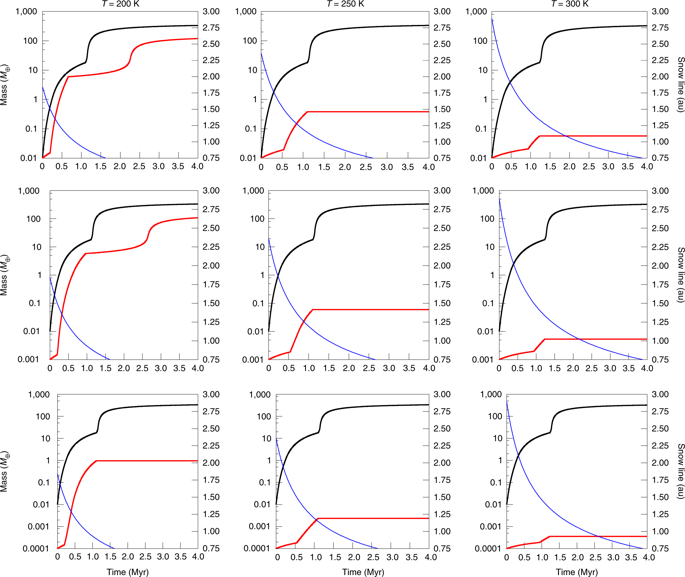Nature Astronomy ( IF 12.9 ) Pub Date : 2020-01-13 , DOI: 10.1038/s41550-019-0978-6 R. Brasser , S. J. Mojzsis

|
Mass-independent isotopic anomalies define two cosmochemically distinct regions: the carbonaceous and non-carbonaceous meteorites1, implying that the non-carbonaceous (terrestrial) and carbonaceous (Jovian) reservoirs were kept separate during and after planet formation. The formation of Jupiter is widely invoked to explain this compositional dichotomy by acting as an effective barrier between the two reservoirs2. Jupiter’s solid kernel possibly grew to 20 Earth masses (\({M}_{\oplus }\)) in 1 Myr from the accretion of submetre-sized objects (‘pebbles’), followed by slower accretion via planetesimals. Subsequent gas envelope contraction led to Jupiter’s formation as a gas giant3. Here, we use dynamical simulations to show that the growth of Jupiter from pebble accretion is not fast enough to be responsible for the inferred separation of the terrestrial and Jovian reservoirs. We propose instead that the dichotomy was caused by a pressure maximum in the disk near Jupiter’s location, which created a ringed structure such as those detected by ALMA4. One or multiple such—potentially mobile—long-lived pressure maxima almost completely prevented pebbles from the Jovian region reaching the terrestrial zone, maintaining a compositional partition between the two regions. We thus suggest that our young Solar System’s protoplanetary disk developed at least one and probably multiple rings, which potentially triggered the formation of the giant planets.
中文翻译:

通过结构化的原行星盘划分内、外太阳系
与质量无关的同位素异常定义了两个在宇宙化学上不同的区域:碳质陨石和非碳质陨石1,这意味着非碳质(陆地)和碳质(木星)储层在行星形成期间和之后保持分离。木星的形成被广泛引用来解释这种成分二分法,因为它充当了两个储层之间的有效屏障2。由于亚米大小的物体(“鹅卵石”)的吸积,木星的固体内核可能在 1 Myr 内增长到 20 个地球质量(\({M}_{\oplus }\)),然后通过小行星缓慢吸积。随后的气体包层收缩导致木星形成气态巨行星3. 在这里,我们使用动力学模拟来表明木星从卵石吸积中的生长速度不够快,不足以负责推断陆地和木星储层的分离。相反,我们提出二分法是由木星位置附近的圆盘中的压力最大值引起的,它产生了一个环状结构,例如由 ALMA 4检测到的环状结构。一个或多个这样的(可能是移动的)长寿命压力最大值几乎完全阻止了木星地区的鹅卵石到达陆地区域,从而保持了两个区域之间的成分划分。因此,我们建议我们年轻的太阳系的原行星盘至少发展了一个甚至可能多个环,这可能触发了巨行星的形成。











































 京公网安备 11010802027423号
京公网安备 11010802027423号